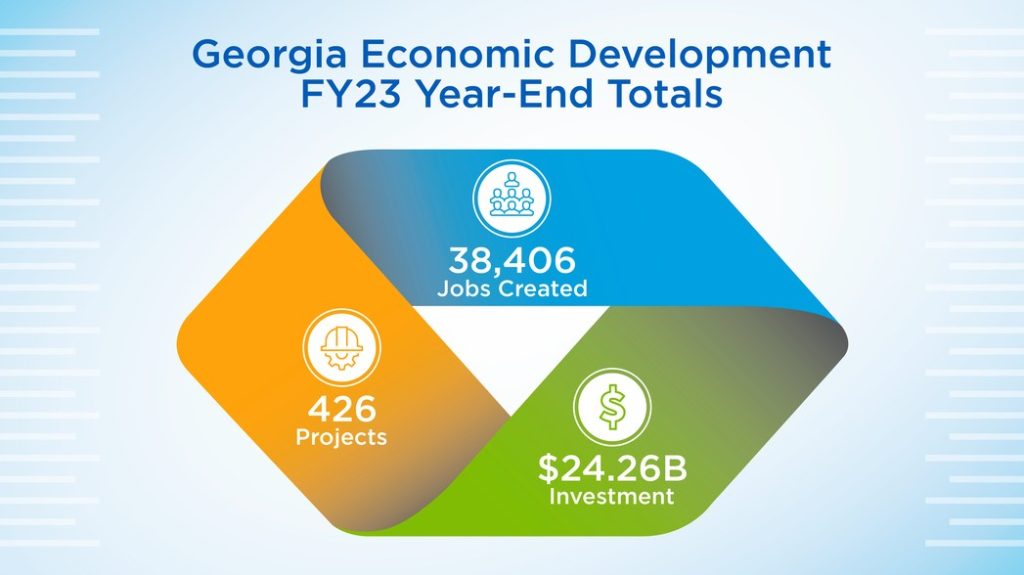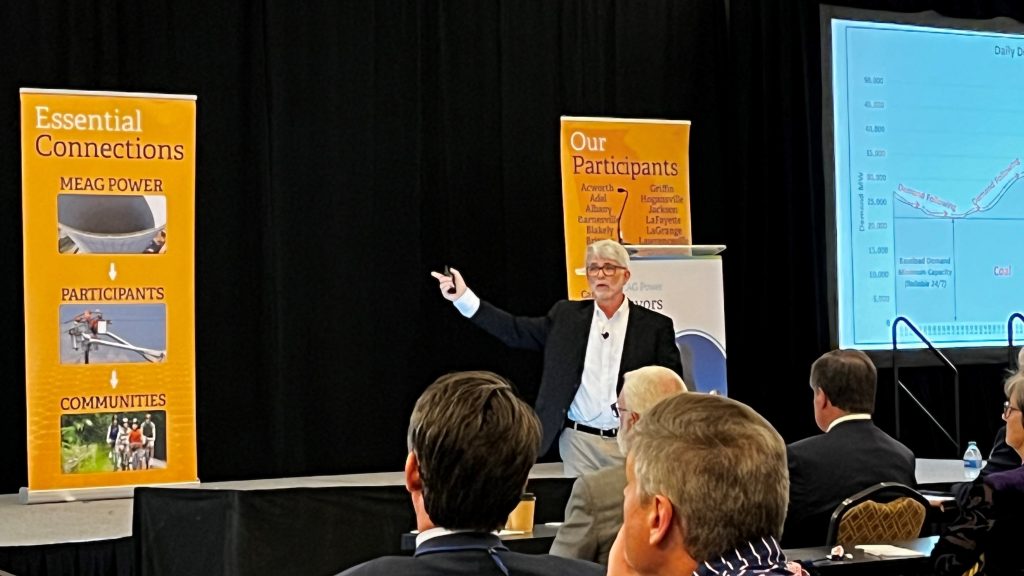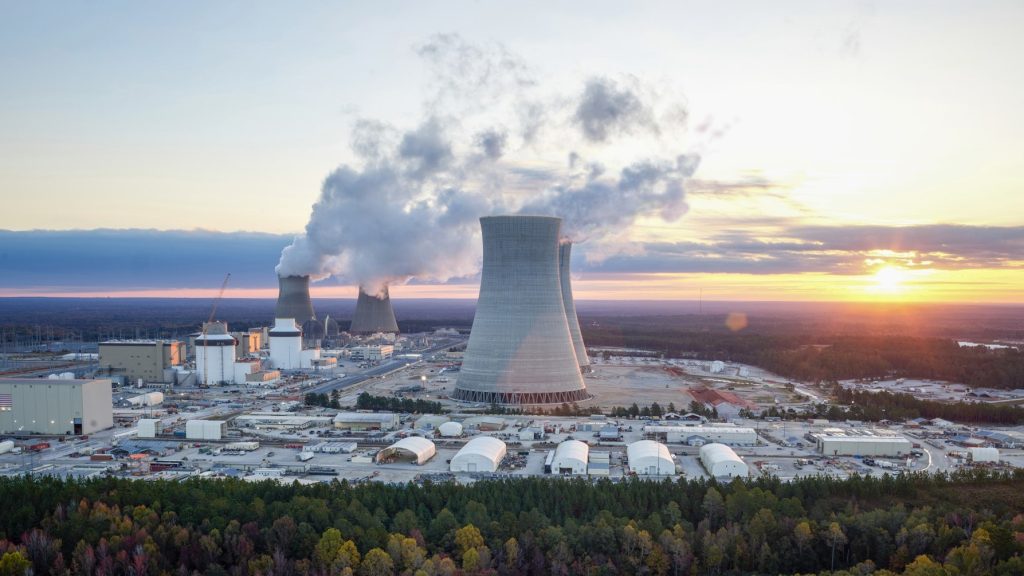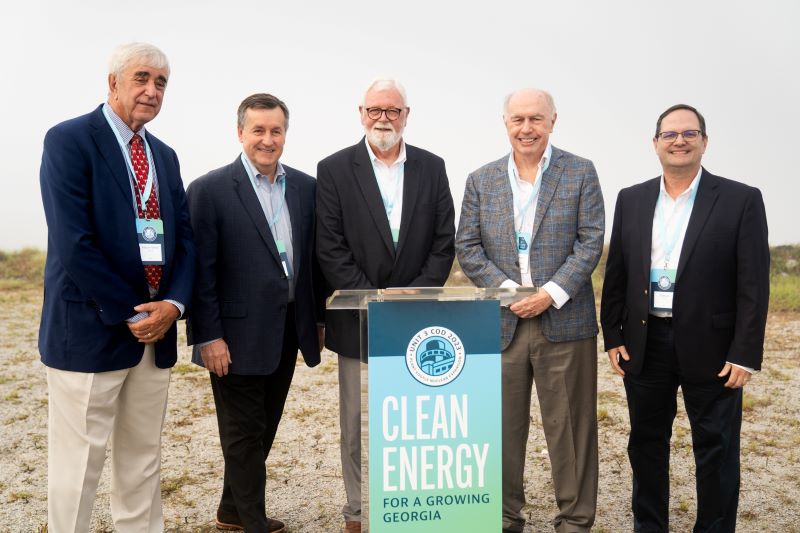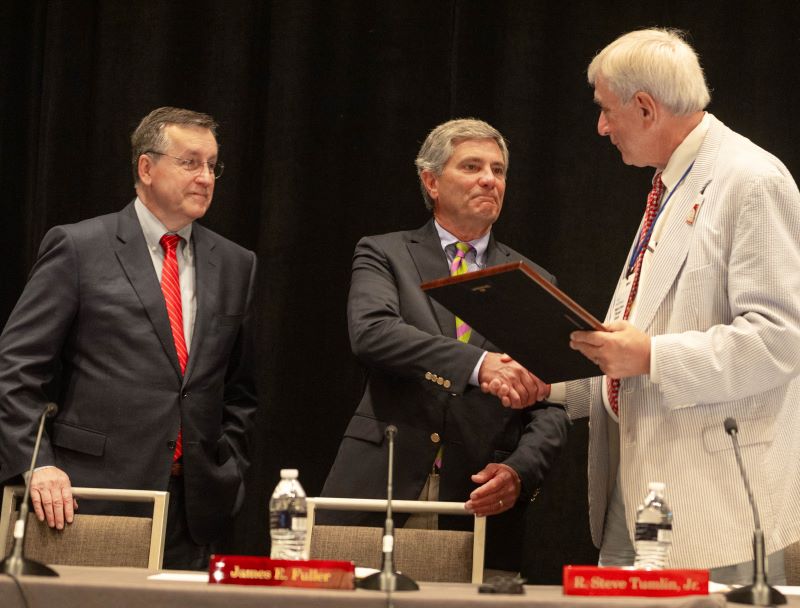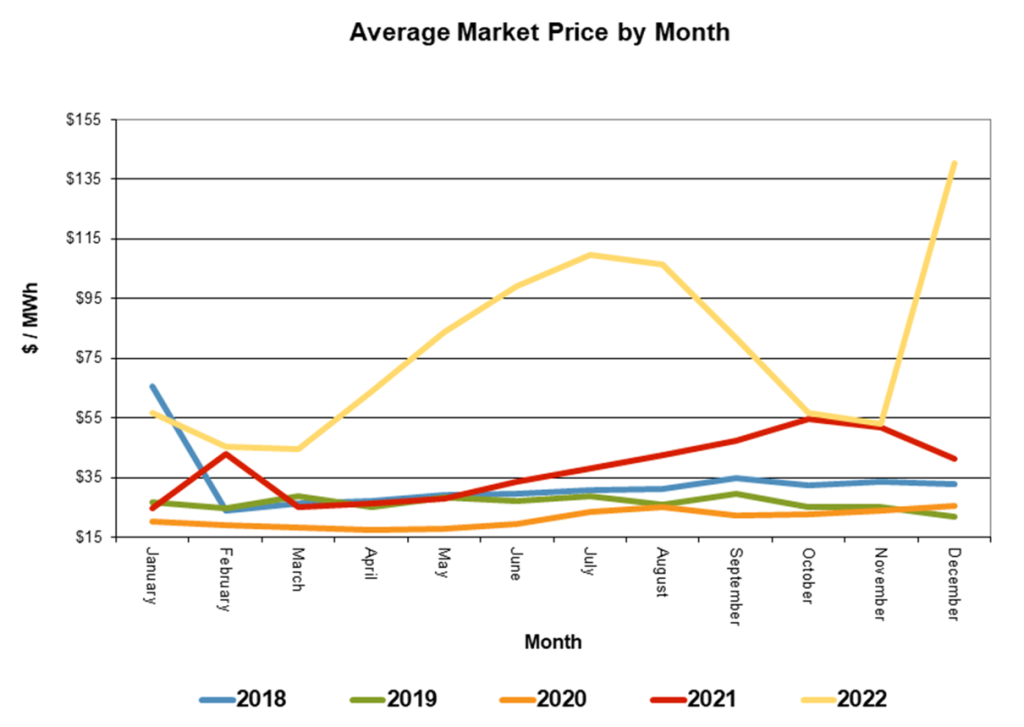The Environmental Protection Agency (EPA) published proposed rules for addressing greenhouse gas (GHG) emissions from fossil fuel-fired electric generating units on May 23, 2023. The rules address existing coal-fired and oil/gas-fired steam power plants, existing large gas-fired combustion turbine power plants and new combustion turbine power plants.
The rules propose sweeping changes to the electricity generation industry within the next 6.5 years, and rely heavily on significant and rapid development of new clean energy infrastructure within the same time frame, supported by trillions of dollars of tax-credit incentives under the Biden Administration’s Inflation Reduction Act. The rules are expected to be finalized in March 2024 and will likely be subject to court challenge.
MEAG Power has worked with our industry trade organizations APPA, LPPC and AFFORD to prepare and submit comments to the EPA on these rules. Also, we’ve prepared our own comments to EPA on how these rules impact our ability to continue to supply low-cost, reliable power to our Participants: click MEAG EPA GHG Comments to view. We have also met with the Georgia Environmental Protection Division (GAEPD) to address our concerns and will continue to meet with other stakeholders to provide our input and concerns.
In addition, MEAG Power is being proactive and evaluating the future options related to Scherer Units 1 and 2. Through the integrated resource plan (IRP) effort, we are evaluating key issues such as what is the likely retirement date, what resources are available to maintain reliability, and are there ways to add certainty into the process. As we wrap up the IRP process later this year, the Participants will be receiving more details on this evaluation.
If finalized as proposed, the rules could have a direct impact on MEAG Power’s ownership share of Plant Scherer Units 1 and 2, as well as a direct impact on new combustion turbine power plants that MEAG may invest in for future power generation needs. And while the Wansley CC combustion turbine units are not considered large gas-fired combustion turbines by EPA under these rules, EPA asserts that they will be addressing the need for GHG rules for all other gas-fired combustion turbine power plants, which will implicate the Wansley CC.
The rules propose essentially four “Best System of Emission Reduction (BSERs)” for reducing GHG emissions from coal-fired power plants: 1) retire prior to Jan. 1, 2032; 2) starting by Jan. 1, 2030, operate at no more than a 20% capacity factor and retire by Jan. 1, 2035; 3) starting by Jan. 1, 2030, co-fire with natural gas at the 40% level and retire by Jan. 1, 2040; and 4) starting by Jan. 1, 2030, capture 90% of the CO2 in the flue gas, transport it and store it in a certified storage facility.
This fourth BSER – called Carbon Capture and Sequestration, or CCS – is currently operating on only one small coal-fired power plant in Canada, and was subsidized by the Canadian government. Based on this experience and other Department of Energy (DOE)-funded engineering and design studies in the U.S., MEAG Power estimates that an investment of upwards of $2.5 billion per Scherer unit could be required to achieve carbon capture. However, capture technology has yet to be demonstrated or proven on units as large as the Scherer units.
In addition to investment in carbon capture, pipelines would need to be built to transport the compressed CO2 gas to a storage facility. These storage facilities are envisioned by EPA and DOE to be underground geological formations such as seams of a former mine. As with carbon capture, such storage facilities are still unproven and undeveloped.
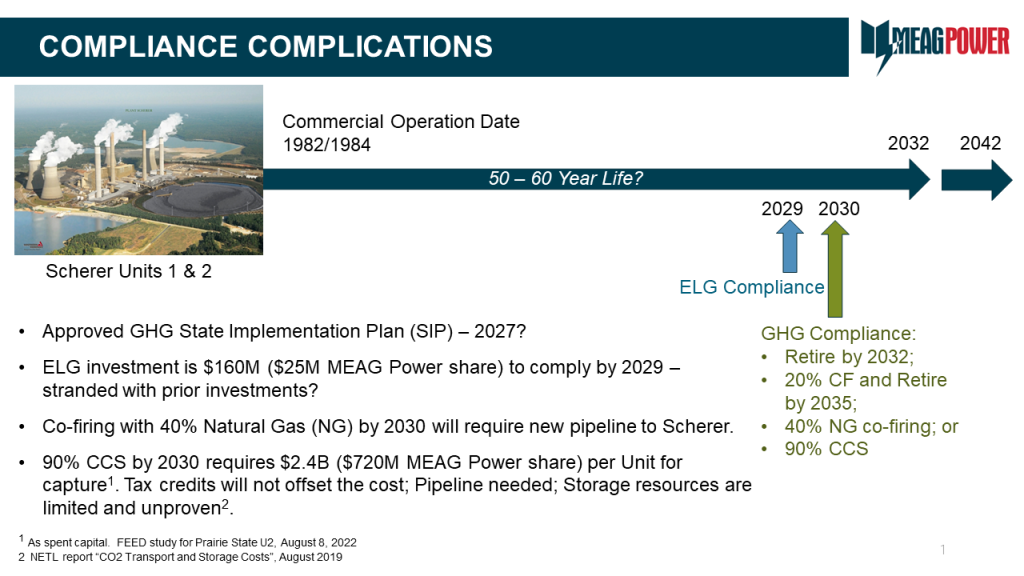 Scherer Units 1 and 2 will be 50 years old by 2032 and 2034, respectively, and ready for either life extension work or retirement. Retrofitting these units with GHG-emissions technologies by 2030 (for either natural gas co-firing or CCS) will result in stranded investment if MEAG Power decides to retire after 50 years of operation.
Scherer Units 1 and 2 will be 50 years old by 2032 and 2034, respectively, and ready for either life extension work or retirement. Retrofitting these units with GHG-emissions technologies by 2030 (for either natural gas co-firing or CCS) will result in stranded investment if MEAG Power decides to retire after 50 years of operation.
For existing large combustion turbine power plants, the rules propose two BSERs: either 1) co-fire with low-GHG hydrogen at the 30% level by Jan. 1, 2032, then increasing to 96% by Jan. 1, 2038, or 2) capture 90% of the CO2 in the flue gas, transport it and store it in a certified storage facility.
Currently, there are very limited supplies of low-GHG hydrogen, so new electrolysis production facilities powered by renewable energy sources will need to be developed, along with a network of pipes and storage facilities to transport large quantities of hydrogen needed by power generation facilities.
EPA’s assessment of the impact on the cost of generation with low-GHG hydrogen co-firing appears to be based on ideal conditions and is somewhat refuted by data provided in Technical Support Documents that accompanied the proposed rule. Based on data provided, we’ve assessed that the cost of 30% and 96% hydrogen blended fuels could be 3 times and 10 times as much as burning natural gas alone, respectively.
And while the cost of technology for capture of CO2 gas is less for combustion turbine power plants than for coal-fired power plants, the required investment is still significant and, again, investment would be needed for transport pipelines and storage facilities.
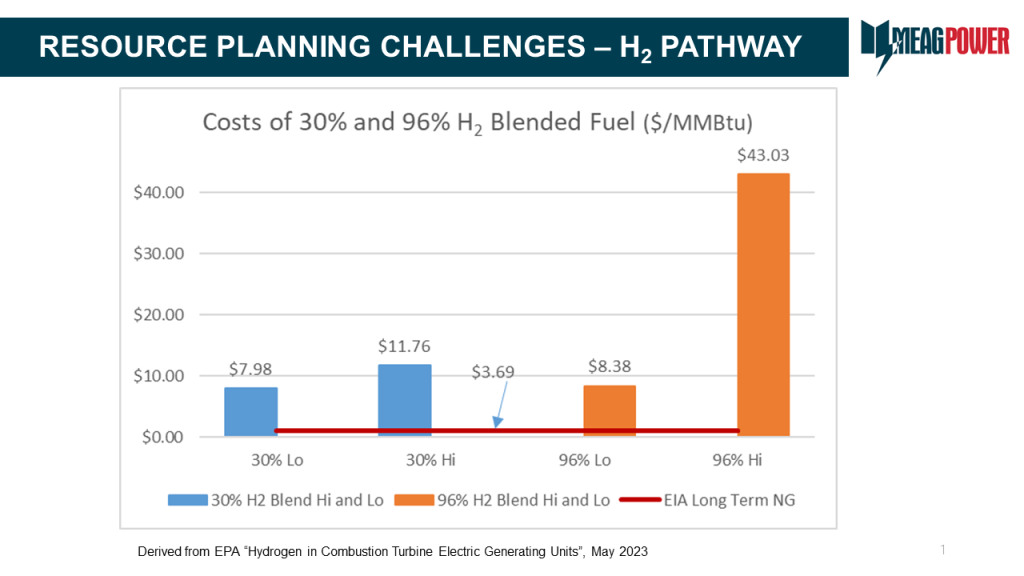
Finally, for new combustion turbine power plants, the rules propose BSERs depending on how the combustion turbine is to be operated. For peaking operation (less than 20% capacity factor), BSER is the combustion of low GHG fuels such as natural gas; for intermediate operation (greater than 20% capacity factor and less than the design efficiency of the turbine (approximately 50% capacity factor), BSER is co-firing low-GHG hydrogen at the 30% level by Jan. 1, 2032; and for base load units (capacity factor greater than design efficiency (approximately 50% capacity factor), BSER is either 1) co-fire with low-GHG hydrogen at the 30% level by Jan. 1, 2032, then increasing to 96% by Jan. 1, 2038, or 2) capture 90% of the CO2 in the flue gas, transport it and store it in a certified storage facility.
It’s difficult to imagine that the infrastructure required for natural gas co-firing at coal-fired power plants, low-GHG hydrogen co-firing at gas plants, and CCS–even though heavily incentivized through the IRA and thus largely supported by US taxpayers–can be in place to meet the proposed rules’ compliance deadlines, as early as 6.5 years out.
During the 5-year period from 2018 through 2022, 66% of the energy supplied by MEAG Power to its communities was emissions-free, resulting in a 5-year average energy supply emission rate of 412 lb. CO2/MWH. MEAG Power’s significant investment in forthcoming emissions-free energy from Plant Vogtle Units 3 and 4, and planned transition away from fossil-fueled resources to renewable resources, show the potential for an economic path for MEAG Power to be nearly 90% emissions-free by 2045.
These proposed rules ignore the huge investment our Participants have already made in environmental control systems for Scherer Units 1 and 2, as well as in new emission-free energy from Vogtle Units 3 and 4.




